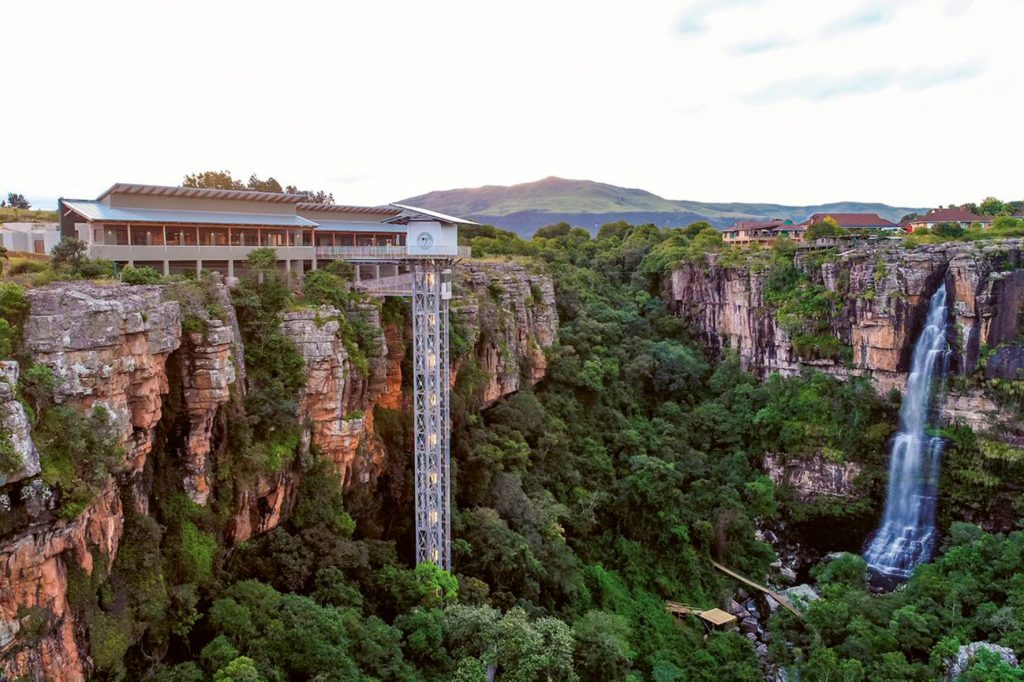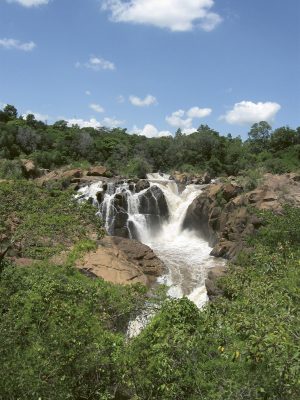The Lowveld is a focal point of beautiful, exciting and adventure-filled places to visit, from world-famous game reserves to quirky living museum towns. We’ve put together a list of a few must-visits in the area, whether you are day-tripping or spending a night (or two).
Panorama Route
Starting in Mbombela, the Panorama Route incorporates a number of attractions and towns. White River is home to the beautiful Casterbridge with its old-world charm, including a motor museum, The Barnyard Theatre, shops, restaurants and ivy-clad walls. Sabie is a quaint and picturesque town, with plenty of adventure on offer, such as 4×4 trips and abseiling, and there are a number of spectacularly scenic waterfalls such as Sabie, Bridal Veil and Mac Mac Falls, and hikes in the area. Pilgrim’s Rest was a gold-mining camp in the 1870s, and is now a national monument protected as a provincial heritage site. The town’s original architecture remains mostly unchanged since the heydays of the gold rush. Graskop is the highlight of the Panorama Route, boasting some of the region’s biggest drawcards, such as God’s Window, the Pinnacle, the Lisbon and Berlin Falls, Blyde River Canyon (the second largest canyon in Africa and third largest in the world) and Bourke’s Luck Potholes.
Graskop Gorge

Centrally located on the Panorama Route, a visit to the gorge is a must. Take a trip down to the spectacular indigenous forest in Graskop Gorge Lift Co’s viewing lift, which descends 51m down the face of the gorge. Walk a 600m trail along the wooden suspension bridges,
revelling in the breathtaking scenery, or indulge in a little thrill-seeking on the longest aerial cable trail or zip line in Mpumalanga with Skyway Trails, which sails you through
300ha of magnificent indigenous forest.
 Kruger National Park
Kruger National Park
Considered one of the most indescribably memorable wildlife experiences in the world, a visit to the Kruger National Park is unmatched. The flagship of South Africa’s national parks and the darling of South Africans, Kruger consists of nearly two million hectares of land stretching from north to south along the border of Mozambique. The sheer diversity of the fauna and flora is incomparable, and while many visitors go to catch a glimpse of the Big 5, there are many who go to simply escape the daily grind and rat race, and listen to the wind sighing through the fever trees. Lighting a fire after a day of game viewing or birdwatching and hearing the haunting call of the fish eagle and the roar of the lion are a balm to any weary soul. You can pop in for a day trip or spend a few nights; either way, the Kruger is the ideal escape. A number of tours are available, although most locals prefer to drive themselves. Nearly all the camps have a restaurant, and there are a number of picnic spots and waterholes dotted throughout. Remember to leave enough time between camps; you never know when you might decide to stop and enjoy a flask of tea at a waterhole.
Kaapsehoop

Quirky and somewhat unconventional, Kaapsehoop is a lovely little town which attracts a large weekend and holiday following. There are a number of pleasant restaurants and pubs, where the beer is cold and live music is fairly common; there is a delightful glasswork factory and the surrounding countryside makes for lovely walking. There are a few hikes for the adventurous through the fascinating and unique rock formations the area is known for, along with the wild horses. Take a stroll along the escarpment, visit the Pear Orchard picnic spot, or indulge a love of the past by going to Adam’s Calendar, thought to be an ancient viewing point built to track the movement of the stars. Discovered by chance when the pilot of a downed plane stumbled across it in 2003, it is the oldest man-made structure on earth, predating the pyramids by tens of thousands of years.
 Sudwala Caves
Sudwala Caves
Set in Precambrian dolomite rock, the Sudwala Caves are part of the Malmani Dolomite Ridge, which in turn is part of the Drakensburg Escarpment. Situated just outside Mbombela, they were shaped around 240 million years ago and are the oldest caves in the world. The cavern complex is dominated by the amphitheatre, an extraordinary chamber which measures 70m in diameter and 37m high, peaking in a dome shape. Named the PR Owen Hall, the amphitheatre’s particular shape makes for excellent acoustics, and it has been the venue for a number of musical performances over the years. Take a look around the butterfly garden, have a fish pedicure, or embark on an incredible 6km subterranean journey by visiting the Crystal Chamber, which lies 2km into the heart of the caves (not for the faint of heart – if you suffer from claustrophobia or back trouble, give this bit a skip and visit the butterfly garden instead!).
 Lowveld National Botanical Garden
Lowveld National Botanical Garden
The Lowveld National Botanical Garden is a magnificent example of the biodiversity of Lowveld flora. The shape of the garden is defined by the two rivers that run through it, the Crocodile and Nels, which come together in a tranquil pool somewhat at odds with the mighty waterfalls that precede the convergence. The waterfalls, which can be viewed from the Cascades and Nels viewpoints, are a huge drawcard to the garden, and visitors come from far and wide to see the spectacular rush of water. Evergreen forest belts occupy the riverbanks, and the Crocodile River’s eastern bank boasts a tropical African rainforest. Walking through it, you access the famous suspension bridge, which also offers views of the cascading waterfall. The garden plays an important role in establishing a cycad gene bank and boasts one of the largest collections of indigenous fig trees.





